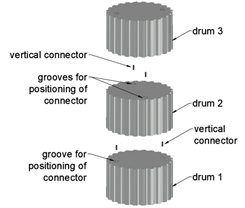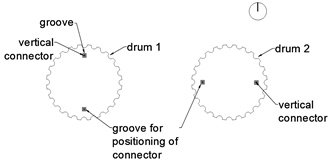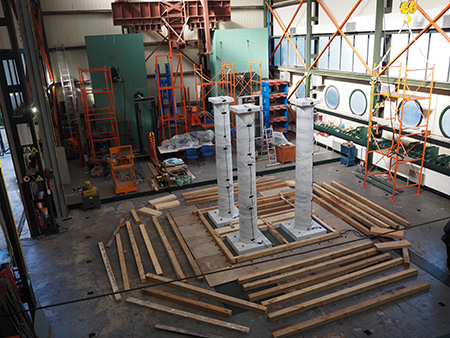Reinforced interfaces between structural members in ancient monuments ΙΑΜΟΝ
Research Responsible: Charalambos Mouzakis, Vasiliki Palieraki
Principal Investigator: Vasiliki Palieraki
The aim of the proposed work is to investigate the effect of interfaces, reinforced using vertical connectors (gomfoi) on the seismic behaviour of ancient monuments. The research focuses on the seismic behaviour of columns and colonnades, where the interfaces between drums are crossed by shear connectors. The proposed work is meant to contribute to a thorough understanding of the observed behaviour and, consequently, to the restoration of monuments of Classical and Roman antiquity. Iron connectors of orthogonal parallelepiped shape (gomfoi) were known to connect mainly horizontal members (beams). However, investigations at Thrasyllos monument (Athens), as well as recent restoration works at the Athens Olympieion (Figure 1), have revealed an arrangement of vertical connectors between consecutive drums of columns, suggesting that it was intended to improve the behaviour of the columns against seismic actions in any direction. The research approach is based on scaled shaking table tests, as well as on modelling of the interfaces and entire columns and subassemblies, with the purpose of reaching reliable experimental results, calibrated numerical models and rational simplifications, adequate describing the behaviour of the studied structures. The proposed work is innovative as it will provide the first in the world experimental evidence (through shaking table tests) on the contribution of vertical connectors on the seismic behaviour of columns and colonnades. This work will be paired with numerical work, which will account for the vertical connectors, based on calibrated experimental results. The use of vertical connectors between the drums of ancient columns offers a possibility for improvement of the seismic behaviour of the restored monument, by adopting a technique invented and applied in ancient monuments, a non-invasive intervention, fully compatible with the Principles of Restoration.
 |
|
 |
|
Figure 1: Arrangement of vertical connectors between consecutive drums (sketch by E. Tavouktsi) |
The aim of the Research Project is to investigate the seismic behavior of columns and colonnades, when the drums' interfaces are reinforced with dowels (gomfoi). Although the presence of iron connectors of rectangular parallelepiped shape was known mainly for connecting horizontal members, the Research Project was based on the dowels found during the recent restoration works at the Olympieion, Athens. The investigation of monuments in the city of Athens, in Peloponnese, with on-site visits, but also in the rest of Greece and in Turkey, through literature study, indicated that dowels were used in many cases, after the Classical Era, that is, during the Hellenistic and Roman Era. The use of dowels was systematic when the column drums were slender, with ratio of height to diameter greater than unity. The use of connectors was systematically studied and recorded in Deliverable D3.1. The on-site investigations were carried out through visual observation, while, wherever possible, namely in the Temple of Hephaestus and Temple of Olympian Zeus, the radar technique was applied, for the in-depth investigation. Based on the study of the monuments and after choosing the monument considered to be the most suitable for the experimental investigation (Gymnasium of Ancient Messene), preliminary analyses were carried out, using two different methods, the analysis with finite elements (FE) or with discrete elements (DE). The two methods led to similar conclusions (Deliverable D3.2). The performed analyses assisted in the design of the experimental program, the selection of the appropriate accelerograph, as well as in the design of the testing instrumentation. The tests, of columns, without and with connectors between the drums, either free-standing, or with architraves, have been completed. The Research Project, when completed, is to contribute to the understanding of the observed behavior and, consequently, to the restoration of monuments of Classical, Hellenistic and Roman antiquity. The Project is innovative in providing the world's first experimental results (via shaking table tests) on the contribution of dowels to the seismic behavior of columns and colonnades. Additionally, the tests are the first performed at scale 1:1. The experimental part of the Project is combined with analysis. Preliminary analyses already performed, will be calibrated based on the experimental results. The use of dowels to connect the drums of ancient columns is expected to offer the possibility of improving the seismic behavior of restored monuments, through a technique (intervention) invented and applied to ancient monuments, fully compatible with the Principles of Restoration. The results of the project have been up to now disseminated as follows:
- (α) Presentation to the international research community through two papers in Proceedings of international Conferences:
(i) ) Palieraki V., Tavouktsi E., Arvanitis C., Karakike E., "Reinforced interfaces between drums in ancient columns", In: Endo, Y., Hanazato, T. (eds) Structural Analysis of Historical Constructions. SAHC 2023. RILEM Bookseries, vol 47. Springer, Cham. https://doi.org/10.1007/978-3-031-39603-8_49. The paper has been accepted for the Conference "Structural Analysis of Historical Constructions". The authors they have sent a poster, which could be seen during the Conference.
(ii) Palieraki V., Valluzzi M.R., Arvanitis C., Salvalaggio M., "Numerical investigation of the structural role of vertical connectors between drums in ancient columns", 18th World Conference on Earthquake Engineering. The Conference will take place in Milan, Italy, 30/06/2024-05/07/2024. The paper has been accepted, and the PI will participate in the Conference and present the paper. - (β) At PM21, a Workshop will be organized in Athens. The Research Team is already dealing with the Organization of the Workshop, and the announcement will be soon available to experts in testing and/or modelling ancient monuments.
 |
|











